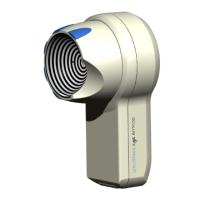Instruction Manual Easygraph
Page 41
Clicking in either of the topographic maps causes the
curvature value and the refractive value at that point
to be displayed.
The data field (at the very bottom) contains the
following parameters:
• Rh: central horizontal curvature radius (in mm
and diopters) and its axis position
• Rv: central vertical curvature radius (in mm and
diopters) and its axis position
• Astig: astigmatism in the center (in diopters)
• Ecc: mean corneal eccentricity
• Pupil: diameter in mm
• Iris: diameter in mm
• Apex: radius in mm and dpt
• Ø, h: measure absolute height difference
The “Spectacle power“ field at the bottom right is
used for entering (and saving) the patient’s refractive
values:
• Sph: spherical equivalent
• Cyl: cylinder (always negative)
• Axis of the cylinder
• CVD: corneal vertex distance
The refraction at the corneal vertex (CVD=0) is
automatically calculated from the spectacle power
values and is likewise displayed numerically.
Before changing spectacle power values of an earlier
examination (i.e. when the examination date differs
from the current date) the system asks “Change the
stored spectacle power values?”, to prevent
inadvertent changing of stored values
When to use the refraction display mode:
This display mode is particularly suitable for studying
measurements before and after excimer laser
treatment because it provides the following
information in a single window:
• normal topographic map (original)
• refractive topographic map
• central radii in diopters
• pupil diameter in mm
• refractive values of the patient at the time of
measurement
Measurement of absolute height difference
To measure absolute height difference means to
measure the difference in height between the apex
and a point on a variable diameter around apex. The
height on the horizontal meridian of astigmatism is
calculated on the basis of a weighted average:
(2 x temp. + 1x nasal)/3.
Height (in terms of µm) is determined at a variable
diameter (mm) around the apex. The diameter of the
zone can be changed by pressing the plus or minus
key. Values thus obtained can be used for fitting
Ortho-K-Lenses.

